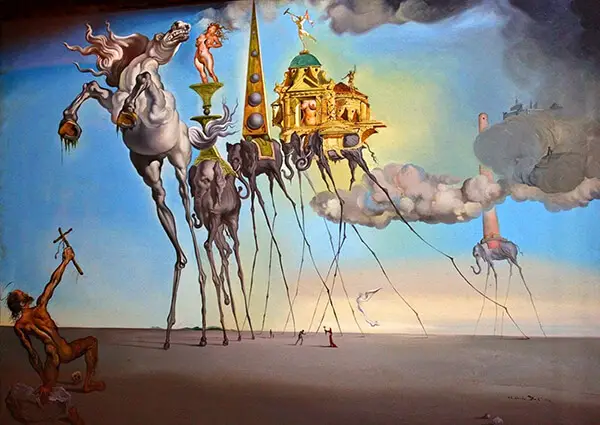It was produced in the United States and is often cited as a precursor to Dali's classical period.
As the name suggests, the painting portrays the series of supernatural temptations reportedly faced by the Christian monk, Saint Anthony the Great, during his Egyptian desert pilgrimage.
Aside from Dali, the most notable artist to explore this particular story was Michelangelo (The Torment of Saint Anthony, 1488).
The items found dotted around this work are their to provide temptation to Saint Anthony.
An elephant with obelisk, inspired by Bernini and repeated in several other Dali paintings including The Elephants.
A nude woman is also offering a clear erotic element to this temptation, and this inevitably lead the eye of the viewer.
Obelisks are also used by Dali in a sexual, phallic sense, though many viewers will find that a marginally subtler addition.
Salvador Dali was motivated to start work on the painting by a competition organised by a film production company. The company specifically wanted entries to depict the story of Saint Anthony's desert temptation, with inclusion in the film The Private Affairs of Bel Ami offered as the prize for the winner.
It was a competition in 1946, organised by the Loew Lewin Company in New York which was the inspiration for Dali to set about this painting.
The title of the painting was precisely the theme for the competition, though it was very rare for this artist to enter such a thing.
Max Ernst was the eventual competition winner, and had faced stiff competition from the likes of Dali and Paul Delaux.
It is believed to be the only art contest Dali ever entered during his lifetime, which gives The Temptation of St Anthony a unique place in history. Work on the painting took place over several days in a studio in New York City.
In total, eleven artists entered the competition, including Dali and the eventual winner, the German artist Max Ernst, who saw his work appear in the film. Nevertheless, Salvador Dali's interpretation would go on to enjoy far greater prominence than Ernst's winning entry.
The painting itself features a nude man, down on one knee, holding a cross up in front of a parade of elephants. Two of the elephants are carrying naked women on their backs, while the remaining elephants are carrying towers. The parade is led by a large horse and the scene is taking place in what is quite clearly a desert.
A surreal element is added to the painting by the long, thin legs of the elephants and horse, which elevate them high into the sky. The horse at the front of the parade is on its hind legs, possibly recoiling in response to the nude man holding up the cross. Dali originally painted The Temptation of St Anthony on canvas, using oil paints.
Given the title and the inspiration behind the work, it is fair to conclude that the nude man holding the crucifix in the painting is a portrayal of Saint Anthony. Similarly, the horse and parade of elephants represent the temptations that Saint Anthony was desperately trying to resist; perhaps through his faith, which is represented by the crucifix.
One of the most important themes explored in the painting is the temptation of human sexuality. This can be seen in the work not only by the appearance of three nude human forms, but also the tall tower on the back of the final elephant in the parade, which has less-than-subtle phallic connotations.
It has been argued by some critics that the horse represents the temptation of power, while the buildings represent home comforts. The animal parade is in the centre of the painting and this, combined with the surreal nature of their appearance and what they represent, means that the viewer's attention is focused strongly on temptations.
By comparison, the figure of Saint Anthony takes up relatively little of the canvas and is painted in fleshy, realistic tones, which contrasts with the bright colours seen in the parade. This could be a technique employed to draw attention away from Saint Anthony, in order to better show the overpowering nature of the temptations he faced.
Despite failing to win the competition for which it was created, The Temptation of St Anthony would go on to become one of Salvador Dali's most famous and influential paintings. Indeed, many scholars have remarked that it is the point at which Dali embraced the stylistic choices associated with classicism.
In many ways, The Temptation of St Anthony can be viewed as a precursor to some of the later Dali paintings, perhaps most notably The Elephants, which was painted two years later. With that said, it can also be viewed as a continuation of ideas explored in works like Dream Caused by the Flight of a Bee... or Swans Reflecting Elephants.
Today, the original painting is located at the Musée Royaux des Beaux-Arts, in Brussels, Belgium.

